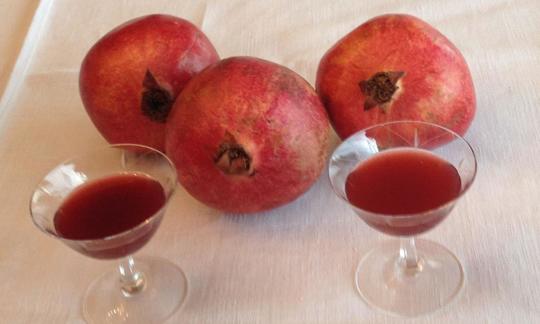Classic Pomegranate Syrup
vegan
Ingredients (for servings, )
| 6 | Pomegranates (grenadine, raw, organic?) (59 oz) |
| 8 ½ oz | Sugar (granulated sugar, sucrose, saccharose) |
Equipment
- stove
- saucepan
- skimmer
Type of preparation
- cook
- can (bottle)
- skim
Preparation
On a firm surface, roll the pomegranates back and forth, applying some pressure, so that the seeds inside burst. Don’t apply too much pressure as this will cause the skin to split. Then make a hole in the pomegranate and pour the juice into a container.
This method does not yield as much juice as the method described under Notes about Recipe. However, the seeds are not completely crushed this way so that the bitter substances don’t get into the juice as is the case when you use a citrus juicer.
If you are making six servings, pour 600 ml of the pomegranate juice through a sieve into a larger saucepan and then bring to a boil.
Add the sugar and let the sweetened juice cook 25-30 minutes on medium heat until the desired syrup-like consistency is achieved and the mixture has cooked down to about 250 ml.
Stir the mixture occasionally during this process.
Use a skimmer to skim off any sugar foam that has formed. Then pour the syrup directly into a bottle with an airtight seal and cap.
|
Nutritional Information per person
Convert per 100g
|
2000 kcal | |
|---|---|---|
| Energy | 395 kcal | 19.8% |
| Fat/Lipids | 3.3 g | 4.7% |
| Saturated Fats | 0.34 g | 1.7% |
| Carbohydrates (inc.dietary fiber) | 94 g | 35.0% |
| Sugars | 80 g | 89.0% |
| Fiber | 11 g | 45.1% |
| Protein/Albumin | 4.7 g | 9.4% |
| Cooking Salt (Na:8.9 mg) | 23 mg | 0.9% |
| Essential micronutrients with the highest proportions | per person | 2000 kcal | |
|---|---|---|---|
| Vit | Vitamin K | 46 µg | 62.0% |
| Vit | Folate, as the active form of folic acid (née vitamin B9 and | 107 µg | 54.0% |
| Min | Copper, Cu | 0.45 mg | 45.0% |
| Vit | Vitamin C (ascorbic acid) | 29 mg | 36.0% |
| Elem | Potassium, K | 666 mg | 33.0% |
| Vit | Pantothenic acid (vitamin B5) | 1.1 mg | 18.0% |
| Vit | Thiamine (vitamin B1) | 0.19 mg | 17.0% |
| Min | Manganese, Mn | 0.34 mg | 17.0% |
| Vit | Vitamin B6 (pyridoxine) | 0.21 mg | 15.0% |
| Elem | Phosphorus, P | 102 mg | 15.0% |
Detailed Nutritional Information per Person for this Recipe
The majority of the nutritional information comes from the USDA (US Department of Agriculture). This means that the information for natural products is often incomplete or only given within broader categories, whereas in most cases products made from these have more complete information displayed.
If we take flaxseed, for example, the important essential amino acid ALA (omega-3) is only included in an overarching category whereas for flaxseed oil ALA is listed specifically. In time, we will be able to change this, but it will require a lot of work. An “i” appears behind ingredients that have been adjusted and an explanation appears when you hover over this symbol.
For Erb Muesli, the original calculations resulted in 48 % of the daily requirement of ALA — but with the correction, we see that the muesli actually covers >100 % of the necessary recommendation for the omega-3 fatty acid ALA. Our goal is to eventually be able to compare the nutritional value of our recipes with those that are used in conventional western lifestyles.
| Essential fatty acids | per person | 2000 kcal |
|---|---|---|
| Linoleic acid; LA; 18:2 omega-6 | 0.22 g | 2.0% |
| Vitamins | per person | 2000 kcal |
|---|---|---|
| Vitamin K | 46 µg | 62.0% |
| Folate, as the active form of folic acid (née vitamin B9 and | 107 µg | 54.0% |
| Vitamin C (ascorbic acid) | 29 mg | 36.0% |
| Pantothenic acid (vitamin B5) | 1.1 mg | 18.0% |
| Thiamine (vitamin B1) | 0.19 mg | 17.0% |
| Vitamin B6 (pyridoxine) | 0.21 mg | 15.0% |
| Vitamin E, as a-TEs | 1.7 mg | 14.0% |
| Riboflavin (vitamin B2) | 0.16 mg | 11.0% |
| Niacin (née vitamin B3) | 0.83 mg | 5.0% |
| Essential macroelements (macronutrients) | per person | 2000 kcal |
|---|---|---|
| Potassium, K | 666 mg | 33.0% |
| Phosphorus, P | 102 mg | 15.0% |
| Magnesium, Mg | 34 mg | 9.0% |
| Calcium, Ca | 29 mg | 4.0% |
| Sodium, Na | 8.9 mg | 1.0% |
| Essential trace elements (micronutrients) | per person | 2000 kcal |
|---|---|---|
| Copper, Cu | 0.45 mg | 45.0% |
| Manganese, Mn | 0.34 mg | 17.0% |
| Zinc, Zn | 0.99 mg | 10.0% |
| Iron, Fe | 0.87 mg | 6.0% |
| Selenium, Se | 1.7 µg | 3.0% |
This classic pomegranate syrup contains only sugar and the juice of pomegranates — there aren’t any artificial flavors or other such additional ingredients.
Pomegranate syrup: Pomegranate syrup is an alcohol-free fruit syrup that is sweetened with sugar and has a deep red color. It is used to add flavor and color to cocktails.
Grenadine is not pomegranate syrup: We need to be careful not to confuse grenadine with pomegranate syrup. Grenadine is a mixture of various berries that often contains artificial fruit flavors, vanilla, dyes, anthocyanins, preservatives, and the like.
Use syrup sparingly: Since it is highly concentrated, you only need to use smaller amounts of the syrup in order to notice in difference in taste in the recipe you are using it for.
Bitter taste using a citrus juicer: Using a citrus juicer is a way to obtain more juice from the pomegranates, but the juice is then somewhat bitter. This is because small pieces of pith get into the juice during the juicing process. These coat the seeds and the many bitter substances they contain then influence the taste of the juice.
Easy way to deseed pomegranates: It works best to cut the pomegranate in half and place in a bowl with cold water. Then use your fingers to release the seeds. They will immediately sink to the bottom of the bowl and the white pith will float to the top. This way you can easily remove the pith and strain out the pomegranate seeds. There are several YouTube videos that clearly explain and show how to use this method to deseed a pomegranate.
Increasing the amount of juice: You can remove the seeds in a water bath and then blend with an immersion blender. This method will prevent any bitter substances from getting into the juice and will also result in an increased amount of juice. However, the pomegranate seeds will be destroyed in the process and you won’t be able to use them for other purposes.
Check the consistency: While the syrup is cooking, you can stir the mixture and then hold the spoon in the air and let the mixture drip off. This way you can tell if the syrup has reached the desired consistency. If it is thick and sticky as are commercial syrups, then the consistency is just right.
Canning syrup: For canning (bottling), it works well to use standard bottles with twist-off caps.
Pomegranate syrup with orange and vanilla flavor: Most alternatives are based on adding additional ingredients, which then accordingly changes the original flavor of the pomegranate syrup. You might, for example, want to add freshly squeezed orange juice, vanilla extract, or star anise.
Amount of sugar: Other recipes for pomegranate syrup often call for large amounts of sugar. The sugar does sweeten the syrup, but excessive consumption of sugar is bad for our health.
Quick version: If you would like shorten the preparation time required, you can purchase pomegranate juice and use this instead of the pomegranates called for in the recipe. Depending on the ingredients in and variety of the juice, the taste of the final product may be somewhat different. Pomegranate juice can usually be found in larger supermarkets and from beverage retailers as well as in many Middle Eastern stores. When you are buying grenadine, it is important to determine the actual percentage of pomegranates it contains.




